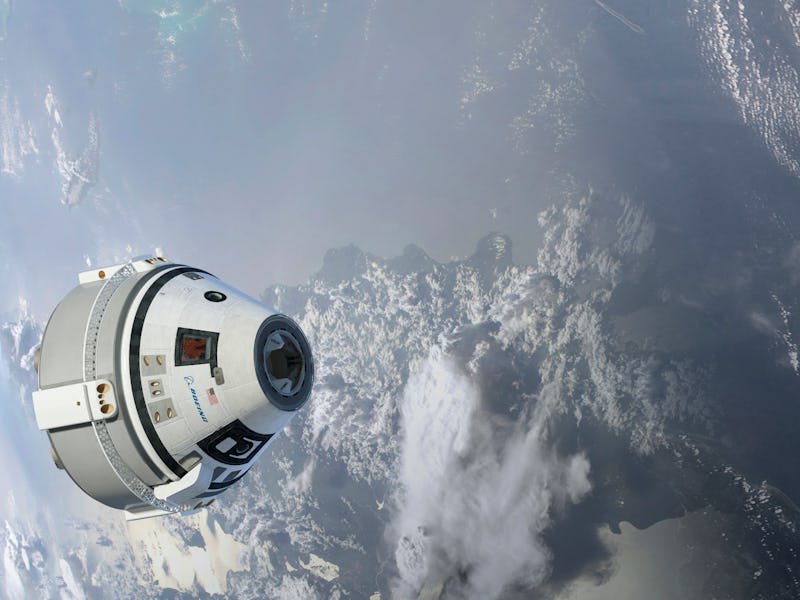Boeing Vs. Elon: How Dennis Muilenburg Could Actually Beat Musk to Mars
Boeing might have one huge advantage over SpaceX.

SpaceX founder Elon Musk threw down the gantlet Thursday on the race to Mars. He took to Twitter to issue a simple “Do it” in response to Boeing CEO Dennis Muilenburg’s assertion that the first person on Mars would get there on one of his company’s rockets.
While Musk’s much-publicized Mars dreams have dominated the conversation around human exploration of the red planet, could Muilenburg actually be right? Does Boeing have what it takes to pull ahead of SpaceX and take the first humans to Mars? To answer that, it’s useful to understand just where each company currently stands and where they are hoping to go.
While there still remain plenty of unanswered questions about the specifics of the companies’ Mars plans, it does appear there’s a key difference in how SpaceX and Boeing view themselves in relation to NASA, and that distinction could shape their eventual paths to the red planet.
Musk’s Mars plans see SpaceX as the main driver. The work SpaceX does in low Earth orbit — both right now as a NASA contractor with its Falcon 9 rocket and in the future with its planned successor, the BFR — are about bringing in the funds and resources necessary so that SpaceX can pay for its own Mars plans. Plans can obviously change a lot between now and 2022, when Musk says the first uncrewed BFR will make the journey to Mars, but for now he has consistently described it as an entirely private venture.
Concept art of Boeing and NASA's SLS.
Boeing, on the other hand, generally describes itself more as a collaborator with NASA. It is developing the Space Launch System in partnership with the space agency. The SLS is the equivalent of SpaceX’s BFR, in that its primary goal is to carry human beyond low Earth orbit for the first time since Apollo 17, with a trip to Mars very much parts of its long-term goal. But whereas SpaceX would presumably have sole discretion over how the BFR is used, Boeing is developing the SLS for NASA’s eventual use.
This is where it’s worth paying attention to Muilenburg’s specific phrasing in his comments to CNBC’s Jim Cramer: “Eventually we’re going to go to Mars and I firmly believe the first person that sets foot on Mars will get there on a Boeing rocket.”
A Boeing rocket, but not necessarily a Boeing mission — based on its current trajectory, it’s more plausible that a Boeing-built SLS rocket would be used on a NASA mission to Mars. And while NASA has experienced plenty of uncertainty and budgetary cutbacks over the past decade in its efforts to get humans back to the moon or go to Mars, it still remains the only organization, public or private, to ever take humans beyond low Earth orbit, and it has all the budgetary resources of the United States government.
Elon Musk and SpaceX might have the most single-minded commitment to getting humans to Mars, but Boeing’s closer partnership could — emphasis on could — end up giving them an advantage.
Right now, it’s safe to say that SpaceX is quite a ways ahead of Boeing in actually demonstrating what it can do as a commercial spaceflight company. While Musk’s Mars ambitions still have a ways to go before they are realized, SpaceX has established that it’s damn good at launching and recovering uncrewed rockets that can take satellites into orbit and deliver payloads to the International Space Station. Its Falcon 9 rocket has gone 16 for 16 in launches this year, with the long-awaited Falcon Heavy set for its maiden flight in January.
A launch of a SpaceX Falcon 9 rocket earlier this year at Cape Canaveral.
Boeing, on the other hand, has eschewed uncrewed rockets in favor of the development of the CST-100 Starliner, aa capsule designed to carry astronauts to the International Space Station. It’s working on that project as part of NASA’s Commercial Crew Development program, which is the space agency’s ongoing effort to support private companies as they develop spacecraft capable of carrying crewed missions to Earth’s orbit.
SpaceX is also involved in that program as it works to redevelop its Dragon capsule to carry people. Boeing and SpaceX are by far the biggest recipients of NASA funding for this project, with Boeing receiving $4.8 billion and SpaceX $3.1 billion of the total $8.3 billion the space agency has invested. And while both companies have pushed the initial deadlines for when their crewed capsules would make their first flights, 2018 is shaping up as a big year for both.
The current plan calls for SpaceX’s Dragon V2.0 to make an uncrewed test flight in February, with a first crewed flight to the ISS provisionally scheduled for June or later. The uncrewed Boeing test is set for June, with a crewed test flight in August and a maiden flight to the ISS in December.
Once one or both of these companies demonstrate they can actually take people into space, we can officially start talking a lot more seriously about who can make it to Mars first. For now, this is mostly speculative, and for all we know it’s entirely possible that it could be NASA and SpaceX, not Boeing, that end up working together to get the first humans to Mars. If nothing else, the next year at least gets us a step closer to taking the companies’ rivalries off of Twitter and onto the launchpad.